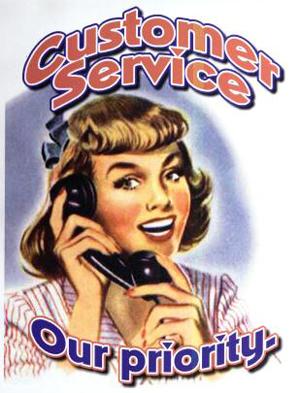Twitter should not be seen as a problem for companies, instead it could be the perfect solution, but only if we move from hearing to actually listening.
 Until now, we may have thought it was just ourselves that had a bad experience with companies, as everyone else receives great customer service from their [insert any company here] provider right? Otherwise if everyone received poor experience surely we’d hear about it wouldn’t we? The media would be all over it.
Until now, we may have thought it was just ourselves that had a bad experience with companies, as everyone else receives great customer service from their [insert any company here] provider right? Otherwise if everyone received poor experience surely we’d hear about it wouldn’t we? The media would be all over it.
However this is clearly not the case. When we “call to complain” as we often do, we have our grievance aired with just one person – the call centre operator, and they are pretty unlikely to tell anyone. If we are really mad we write a letter in the hope it gets published in a newspaper, except the newspapers are funded by advertising, and probably by the company we’re complaining about – so chances are our letter never sees the light of day.
If we’re smart, we complain to the industry authority, or the relevant ombudsman, or someone who we hope will care.
Months go by, and we find that we’re in a pile of other complaints also being investigated by other consumers who have also had a similar bad experience.
In each of these cases, our complaint rarely goes public, so it doesn’t get carried by the mainstream media.
Fast forward to the latter stages of 2006 and now we are finding that there are different ways to complain – and complain in a big way.
Blogs were the first “self publishing” platforms where we did not have to wait for the Editor of a newspaper or TV station to run our letter. We were the editor. The problem was that the general public (or journalists) weren’t reading blogs and there were so many of them that it was hard to get our message out above the noise.
Fast forward to the latter stages of 2008 when Facebook is starting to hit its strides, and Twitter is becoming a much louder voice on a truly global scale.
Indeed, the network effect from social networking has provided the voice to previously silent complainants. Now their voice can be heard (instantly) by a much wider audience, and in real time and their message can be re-told (re-tweeted) endless times.
More often than not, a story that starts on twitter gains so much momentum that Journalists (also now on twitter) see the story and make it the issue of the day.
I often advise clients that the “perfect storm” is a slow news day and a single person complaining on Twitter that then becomes a firestorm, and jumps from social media to mainstream media.
 So we can look at customer service in two ways
So we can look at customer service in two ways
The old way: complain to one person via call centre. They promise to fix the problem. The problem does not get fixed, we call customer service again. They promise to fix the problem. Repeat.
The new way: Don’t bother calling the call centre, post your gripe on Twitter. 15 minutes later get a response, they then call you to find out what the issue is and the same person fixes the problem, and you tell your friends how wonderful they are etc
In fact I no longer call my UK telephone providers BT or Vodafone via their call centres. I tweet @BTCare and @VodafoneUK and they call me (amazing but true!)
Blue-chip clients I deal with on a daily basis in the UK and Australia fret about “what happens when all of our customers do what you do”. “Do we need an airport hangar full of people on twitter just to respond?” they ask.
Well the answer may be a little more simple. What about if we used all of this rich customer feedback from Twitter and other networks and actually moved our approach from hearing to actually listening and understand what is being said.
Most of the clients I consult to agree with many of the complaints that are posted, but they seem powerless (or hamstrung by 1980’s processes and thinking) to make any changes.
A good friend of mine Jonathan Salem Baskin penned an excellent article in Ad Age titled “the twitter tax” (http://lc.tl/ttax)
In the article he argues
“Tools like Twitter aren’t some dream of customer empowerment, but rather the nightmare reality of the broken relationships between consumers and brands. Responding to online complaints is a tax that companies pay because of the chronic mismatch between what consumers expect from brands and what they ultimately get. An individualized response might momentarily bridge the gap, but it won’t fix it. Never will
And here he has hit the nail on the head.
As I have hopefully pointed out in this article, Twitter is not the enemy of the marketer or customer service director, it is their new best friend if only they would embrace what is being said and actually move towards fixing the problems. Fixing the problems that have always been there, but have been expertly hidden behind endless “customer satisfaction” surveys, and “push one to speak to a human” interactive voice systems for way too long.
Some companies I speak to openly admit that they want to make it hard to contact them and so don’t publish email addresses or direct phone numbers on their websites. They do this knowing that customers will call to complain because multiple processes are broken.
So back to the title of the article – if we fix the inherent customer service issue, we may have nothing to complain about on Twitter!
Better still, removing all of the customer service issue noise from Twitter and other channels will allow us to hear what our customers need more easily, and work towards a more accelerated product development process where feedback is gathered and new products developed on the strength of it.
This is where the real power of always-on real time customer feedback lies.
No longer can a Chief Executive allow just the PR or marketing departments to control what they are hearing on social media networks. The head of customer service needs to be deeply plugged in as well.
Andrew Grill is on Twitter @andrewgrill


